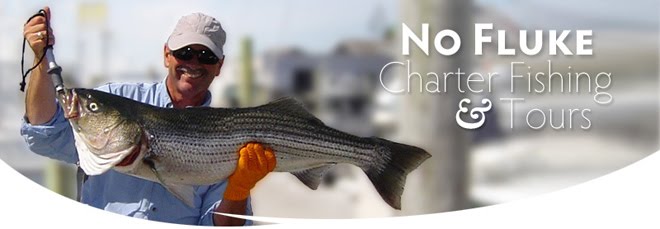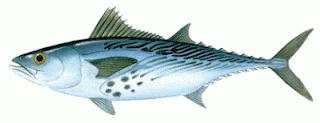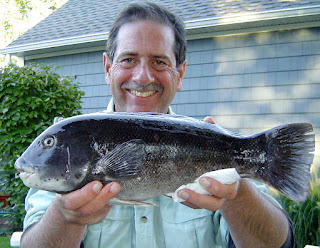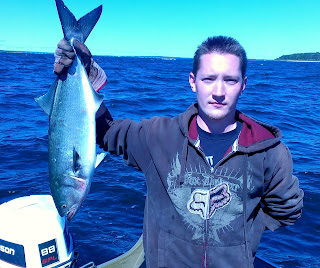Fishing
after storms can be good: fish like this long 41”, 20.5 pound striped
bass caught a couple of weeks ago by Albert Bettencourt of East Providence can
be caught after storms too. Al was drifting
eels off Barrington Beach at 3:45 a.m. when this fish hit.
Fishing before and after
storms
Many anglers believe the best time to fresh or saltwater fish is before a storm… before a cold front moves in. They believe the fish feel the difference in barometric pressure… the front moves in, the pressure drops and it triggers a feeding frenzy. I guess the fish sense bad weather so they eat while the eating is good. Many also believe that during and after a storm fishing is not good as the water is turbid and cloudy so fish cannot even see the most attractive bait. However, this is not necessarily true.
Sometimes fishing after a storm is good. Just like any other
time, the right time to fish depends on a lot of variables… water temperature,
oxygen level in the water, water movement, structure and most importantly bait
in the area that fish can feed on. Safety is the most important thing to
remember when fishing before and after storms. I head for shore if the weather
is threatening, if on shore do not take any risks fishing near high surf that
is unpredictable. Wait until things calm down.
Fishing after can be good after rain storms, tropical storms,
even hurricanes… the quality of fishing depends on a lot of variables. For
example, flooded areas create new fish habitats with a new food supply of
insects, shrimp, shell fish and small fish that arrive with the water. These
flooded areas and waters adjacent to them can become good fishing areas as the
water starts to recede.
Fishing after storms has been good for shore, near coastal and
Bay fishermen. Anytime you can get close to inlets, the shore or underwater
structure you will do well. Fishing is good at inlets and outflows because
water levels are high due to rain, abnormally high tides and heavy surf. Once
water rushes out of rivers, bays, and inlets, bait that may have sought refuge
up inlets gets tossed around as they leave for open water where larger fish are
waiting.
Other contributing factors to good fishing after storms are
geography and storm patterns. For example, with storm winds coming out of the
southeast, south and southwest… bait, crabs, oysters, mussels, clams, etc. get
crushed and pushed to the opposite shoreline or get hung up on ridges. These
areas become prime feeding grounds for hungry fish. Good idea to try clams and
split crabs as bait when fishing after a storm in these areas.
During the hurricane season a couple of years ago I asked a
couple of noted local anglers what they thought about fishing after storms.
Here is what they had to say. Fish the opposite shoreline after a storm and you
are more likely to catch fish because the bait is there said Steve McKenna of
Cranston, an associate at Quaker Lane Outfitters in North Kingstown. Steve
said, “I like to fish the fist clearing wind after a big storm once the sea
settles down a bit… I caught my last three 40 lb. striped bass after storms.”
Captain Rich Hittinger said, “At the end of the season, storms have sometimes sent the fluke packing to deeper water with no significant bite until the following spring. It also can chase the giant tuna out of here for the season, but we can only wait and see what happens. In any case the scup, sea bass, and stripers will still be here after the storm, but it may take a few days before they settle back into a feed.”
Mark Pietros comments about cod fishing after a storm on the RISAA fishing blog , “I went out… a couple days after that rain and wind storm. It wasn't a hurricane but the seas were pretty bad a few days before. When we went out the "weathermen" were calling for a small craft warnings. The seas were actually one foot or less, it was a great day. We had all the cod action we could handle along with a few haddock, pollock and the biggest hake I have ever seen….I have been out several times after storms and have had good luck when fishing in deeper water.”
Captain Rich Hittinger said, “At the end of the season, storms have sometimes sent the fluke packing to deeper water with no significant bite until the following spring. It also can chase the giant tuna out of here for the season, but we can only wait and see what happens. In any case the scup, sea bass, and stripers will still be here after the storm, but it may take a few days before they settle back into a feed.”
Mark Pietros comments about cod fishing after a storm on the RISAA fishing blog , “I went out… a couple days after that rain and wind storm. It wasn't a hurricane but the seas were pretty bad a few days before. When we went out the "weathermen" were calling for a small craft warnings. The seas were actually one foot or less, it was a great day. We had all the cod action we could handle along with a few haddock, pollock and the biggest hake I have ever seen….I have been out several times after storms and have had good luck when fishing in deeper water.”
Two additional theories about fishing after storms: first, big
storms do not necessarily bother fish in deep water, so bottom fishing offshore
for fluke, tautog and other species may not be affected at all. Secondly, with
fish not feeding much during a big blow they are very interested in eating as
soon as things clear. Both fresh and saltwater anglers have related success
using surface plugs once winds settle down as water throughout the water column
may still be turbid and cloudy after a storm even though the seas have calmed.
Surface plugs splashing around on the surface will likely get the attention of
hungry fish.
Try some of these storm fishing tactics and let us know what
works for you by e-mailing your comments to www.dmontifish@verizon.net .

.jpg)






.jpg)







.jpg)
